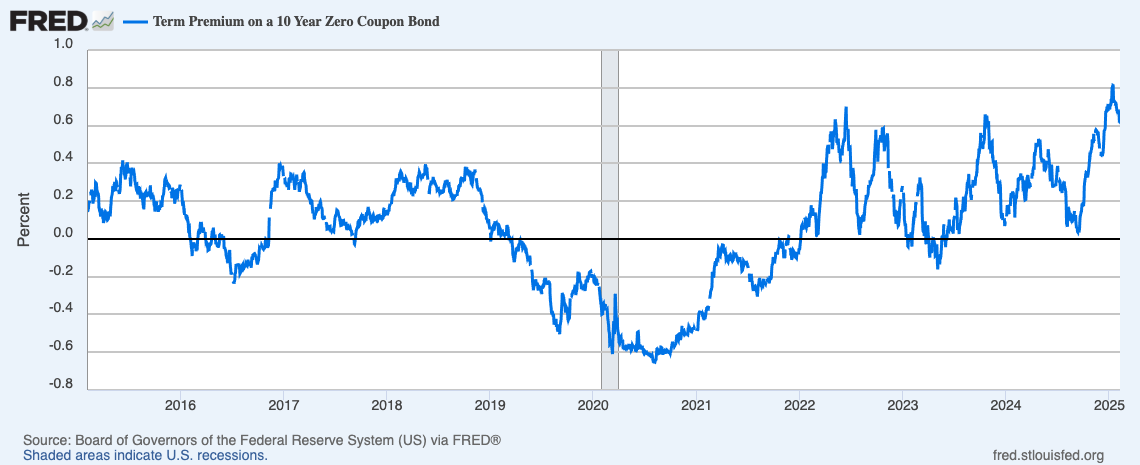If you want to know where markets are going, you need to understand the mechanics of money and credit. Markets move in cycles, and those cycles are largely dictated by interest rates, liquidity conditions, and risk premiums. One of the most important indicators of these forces is the 10-year term premium—which reflects how much extra return investors demand to hold long-term government bonds instead of rolling over short-term debt. When it moves significantly, it signals a major shift in market dynamics.
A Look at the Term Premium Over Time
The Federal Reserve Economic Data (FRED) chart tracking the 10-year term premium over the past decade provides a clear picture of how market psychology and macroeconomic conditions interact.
- 2019-2021: The Negative Term Premium and the COVID Crisis
- In 2019, the term premium fell below zero, indicating that investors were prioritizing safety and expecting prolonged low interest rates due to slowing global growth.
- The massive drop in early 2020 coincided with the COVID crisis. Investors flocked to Treasuries, pushing yields down and signaling expectations of heavy Federal Reserve intervention.
- A negative term premium means that investors believe rates will remain low for an extended period, reinforcing liquidity-driven market rallies.
- 2022-2025: The Rebuilding of Risk Premiums and Inflationary Uncertainty
- Since 2022, the term premium has been steadily increasing, driven by inflation concerns, aggressive Fed tightening, and rising government debt levels.
- The term premium recently surpassed 50 basis points for the first time since 2014, a clear signal that investors are demanding more compensation for taking long-term risks.
- This rise suggests that the market is adjusting to a new regime of structurally higher interest rates and long-term economic uncertainty.

The Recent Surge and Its Implications
A significant development in recent weeks has been the sharp rise in long-term U.S. Treasury yields, which is impacting global markets. This shift indicates a rebuilding of risk premiums across debt markets due to fiscal and monetary concerns.
- The New York Fed’s estimate of the 10-year term premium hit its highest level in a decade, reflecting growing concerns about inflation, debt supply, and political uncertainty.
- The 30-year Treasury yield has climbed to its highest level since 2023, with 10-year yields also reaching their highest point in almost nine months.
- The yield curve steepened dramatically, with the gap between 2-year and 30-year bonds reaching its widest level since the Fed began hiking rates in 2022.
- Strong labor market data and rising service sector inflation have fueled speculation that the Fed may need to keep rates higher for longer.
The bond market’s reaction has created ripple effects across asset classes:
- Rising Treasury yields strengthen the dollar, making U.S. assets more expensive for foreign investors.
- Higher borrowing costs dampen economic growth, leading to a potential slowdown in corporate earnings.
- Stock markets are beginning to feel the pressure, with growth stocks particularly vulnerable due to their sensitivity to discount rates.
- European stocks, however, have shown resilience, buoyed by defense spending discussions within NATO and a stronger banking sector.
What This Means for Investors
The bond market is the most reliable predictor of long-term economic trends. It reflects the real-time expectations of market participants regarding growth, inflation, and liquidity conditions. Here’s what the rising term premium tells us:
- Rising Term Premium = Tighter Financial Conditions
- Higher long-term interest rates increase borrowing costs across the economy.
- This slows economic activity, reduces credit creation, and weakens corporate profit growth.
- The Market is Repricing Risk and Inflation
- Investors are demanding higher returns for holding long-term bonds, indicating uncertainty about future inflation and debt sustainability.
- Growth stocks and speculative assets are particularly vulnerable as discount rates rise.
- Geopolitical and Fiscal Risks Are Playing a Bigger Role
- The current increase in term premiums isn’t just about monetary policy—it’s also driven by fiscal uncertainty, government debt levels, and political developments.
- Global capital flows are shifting, and investors need to consider these macro forces when allocating capital.
Markets are transitioning into a different environment—one where inflation, interest rates, and fiscal policy matter much more than they did in the previous decade. The bond market is often the first to recognize these shifts, and right now, it’s flashing clear warning signs. The rising 10-year term premium signals a fundamental tightening of financial conditions, which could lead to economic slowing, equity market volatility, and changing investment dynamics.
Smart investors will recognize these signs and position themselves accordingly. The key is to understand the structural changes at play, anticipate the next move, and stay ahead of the curve.



